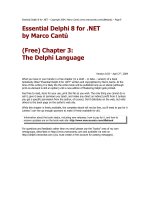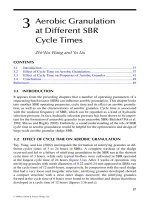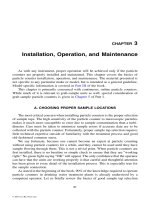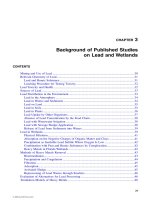Chapter 3 ideal reactors for single reactions
Bạn đang xem bản rút gọn của tài liệu. Xem và tải ngay bản đầy đủ của tài liệu tại đây (2.6 MB, 16 trang )
VIETNAM NATIONAL UNIVERSITY – HO CHI MINH CITY
UNIVERSITY OF TECHNOLOGY
FACULTY OF CHEMICAL ENGINEERING
Chemical Reaction Engineering
(Homogeneous Reactions in Ideal Reactors)
Mai Thanh Phong, Ph.D.
FCE – HCMC University of Technology
Chemical Reaction Engineering
Chapter 3. Ideal Reactors for a Single Reaction
1. Material and energy balances
The starting point for all design is the material balance expressed for any
reactant (or product).
Figure 3.1 Material
balance for an element
of volume of the reactor.
Thus, as illustrated in Fig. 3.1, we have
Mai Thanh Phong - HCMUT
Chemical Reaction Engineering
Apr 8, 2023
2
Chapter 3. Ideal Reactors for a Single Reaction
In nonisothermal operations energy balances must be used in conjunction with
material balances.
Figure 3.2 Energy balance for
an element of volume
of the reactor.
Thus, as illustrated in Fig. 3.2, we have
Mai Thanh Phong - HCMUT
Chemical Reaction Engineering
Apr 8, 2023
3
Chapter 3. Ideal Reactors for a Single Reaction
In this chapter we develop the performance equations for a single fluid reacting
in the three ideal reactors shown in Fig. 3.3. We call these homogeneous
reactions.
Figure 3.3 The three types of ideal reactors: (a) batch reactor, or BR; (b) plug
flow reactor, or PFR; and (c) continuously stirred tank reactor, or CSTR.
Mai Thanh Phong - HCMUT
Chemical Reaction Engineering
Apr 8, 2023
4
Chapter 3. Ideal Reactors for a Single Reaction
2. Batch reactor (BR)
Make a material balance for any component A. Noting that no fluid enters or
leaves the reaction mixture during reaction, the material balance written for
component A is
or
Mai Thanh Phong - HCMUT
(3.1)
Chemical Reaction Engineering
Apr 8, 2023
5
Chapter 3. Ideal Reactors for a Single Reaction
n
n
n
(3.2)
By replacing these two terms in Eq. 3.1, we obtain
n
(3.3)
Rearranging and integrating then gives
n
(3.4)
If the density of the fluid remains constant, we obtain
with
Mai Thanh Phong - HCMUT
Chemical Reaction Engineering
(3.5)
Apr 8, 2023
6
Chapter 3. Ideal Reactors for a Single Reaction
For all reactions in which the volume of reacting mixture changes
proportionately with conversion, Eq. 3.4 becomes
(3.6)
n
3. Continuously stirred tank reactor (CSTR)
Figure 3.4 Notation for a CSTR
rAf = rA
Mai Thanh Phong - HCMUT
Chemical Reaction Engineering
Apr 8, 2023
7
Chapter 3. Ideal Reactors for a Single Reaction
By selecting reactant A for consideration, material balance for a CSTR can be
written as follows
(3.7)
As shown in Fig. 3.4, if FA0 = v0CA0 is the molar feed rate of component A to
the reactor, then considering the reactor as a whole we have
Introducing these three terms into Eq. 3.7, we obtain
(3.8)
Mai Thanh Phong - HCMUT
Chemical Reaction Engineering
Apr 8, 2023
8
Chapter 3. Ideal Reactors for a Single Reaction
which on rearrangement becomes
(3.9)
Mai Thanh Phong - HCMUT
Chemical Reaction Engineering
Apr 8, 2023
9
Chapter 3. Ideal Reactors for a Single Reaction
More generally, if the feed on which conversion is based, subscript 0, enters
the reactor partially converted, subscript i, and leaves at conditions given by
subscript f, we have
(3.10)
For the case of constant-density systems XA = 1 – CA/CA0:
(3.11)
Mai Thanh Phong - HCMUT
Chemical Reaction Engineering
Apr 8, 2023
10
Chapter 3. Ideal Reactors for a Single Reaction
Figure 3.5 is a graphical representation of these mixed flow performance
equations.
3.9
3.11
Figure 3.5 Graphical representation of the design equations for CSTR.
Mai Thanh Phong - HCMUT
Chemical Reaction Engineering
Apr 8, 2023
11
Chapter 3. Ideal Reactors for a Single Reaction
4. Plug flow tubular reactor (PFTR)
Figure 3.6 Notation for a plug
flow tubular reactor.
At the steady-state, the material balance for reactant A becomes
(3.12)
Mai Thanh Phong - HCMUT
Chemical Reaction Engineering
Apr 8, 2023
12
Chapter 3. Ideal Reactors for a Single Reaction
Referring to Fig. 3.6, we see for volume dV that
Introducing these three terms into Eq. 3.12, we obtain
Noting that
We obtain
Mai Thanh Phong - HCMUT
(3.13)
Chemical Reaction Engineering
Apr 8, 2023
13
Chapter 3. Ideal Reactors for a Single Reaction
For the reactor as a whole the expression must be integrated. Grouping the terms
accordingly, we obtain
Thus
(3.14)
For a more general expression, we have
(3.15)
Mai Thanh Phong - HCMUT
Chemical Reaction Engineering
Apr 8, 2023
14
Chapter 3. Ideal Reactors for a Single Reaction
For the special case of constant-density systems
We have
(3.16)
Mai Thanh Phong - HCMUT
Chemical Reaction Engineering
Apr 8, 2023
15
Chapter 3. Ideal Reactors for a Single Reaction
3.14
3.16
Figure 3.7 Graphical representation of the performance equations for plug flow
tubular reactors.
Fig. 3.7 displays these performance equations and shows that the space-time
needed for any particular duty can always be found by numerical or graphical
Integration.
Mai Thanh Phong - HCMUT
Chemical Reaction Engineering
Apr 8, 2023
16









